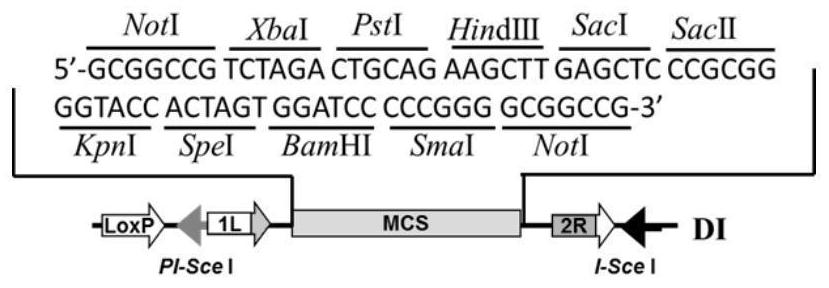Application of photorespiratory branch protein in regulation and control of plant traits
A photorespiration and plant technology, applied in the fields of applications, plant peptides, plant products, etc., can solve the problems of the photorespiration metabolism of food crops and other reports
- Summary
- Abstract
- Description
- Claims
- Application Information
AI Technical Summary
Problems solved by technology
Method used
Image
Examples
Embodiment 1I
[0440] Example 1 Regulatory effect of II-GOC photorespiratory branch on rice traits
[0441] In the present invention, OsGLO, KatE and OsOXO are co-expressed to construct II-GOC photorespiratory branch in rice.
[0442] 1.1 Acquisition of TPC-OsGLO3, TPC-OsOXO3, and TPC-KatE fusion protein expression genes
[0443] (1) Acquisition of TPC-OsGLO3 fusion protein expression gene
[0444] Primers were designed according to the cDNA sequences of OsGLO3 and TPC provided by NCBI (http: / / www.ncbi.nlm.nih.gov / ).
[0445] Using cDNA of 2-week-old japonica rice seedling leaves as a template, under the guidance of primers OsGLO3-F and OsGLO3-R, and primers TPC-1F and TPC-1R, the OsGLO3 and TPC genes were amplified by conventional methods, respectively. After the reaction, the PCR amplified product was subjected to 1% agarose gel electrophoresis, and the DNA fragments of OsGLO3 (about 1100bp) and TPC (about 150bp) were recovered and purified; The ligase was used as a template for the sec...
Embodiment 12
[0452] Example 1.2 Obtaining of TPC-OsGLO3, TPC-OsOXO3, TPC-KatE Fusion Protein Expression Cassette Sequences
[0453] (1) Acquisition of TPC-OsGLO3 fusion protein expression cassette Pubi-TPC-OsGLO3-Tnos
[0454] Primers were designed according to the expression gene sequence of TPC-OsGLO3 fusion protein, using the pMD18-TPC-OsGLO3 vector described in Example 1.1 as a template, under the guidance of primers TPC-OsGLO3-F and TPC-OsGLO3, amplify TPC-OsGLO3 by conventional methods The gene was recovered by electrophoresis and cloned into the recombinant donor vector Pubi-DI (for the vector map, see figure 2 ) Between the PstI and BamHI restriction sites of the multiple cloning site, the vector Pubi-DI-TPC-OsGLO3 was obtained.
[0455] Design primers according to the Pubi promoter sequence and Tnos terminator sequence on the Pubi-DI vector, use the above-mentioned Pubi-DI-TPC-OsGLO3 vector as a template, and amplify using conventional methods under the guidance of primers Pubi-...
Embodiment 13
[0462] Example 1.3 Obtaining GOC-pYL1305 carrier for transformation of GOC photorespiratory metabolic branch
[0463] With Pubi-DI-TPC-OsGLO3, 2×P35s-DII-TPC-OsOXO3 and Pubi-DI-TPC-KatE as donor vectors, pYL1305 (for the vector map, see Figure 4 ) is the acceptor carrier, referring to the method of Lin et al. (10):5962-5967), through three rounds of recombination, the GOC photorespiratory metabolic transformation branch carrier GOC-pYL1305 was finally obtained, and the vector map is as follows Figure 5 shown. The specific reorganization method is as follows:
[0464] (1) Preparation of donor plasmid and recipient plasmid
[0465] Collect 10 mL of the overnight bacterial solution, extract the plasmid with a plasmid mini-extraction kit, detect and measure the plasmid concentration by electrophoresis, and control the plasmid concentration at 100-200 ng / μL.
[0466] (2) Co-transfection and recombination of donor plasmid and recipient plasmid
[0467] Mix 3-4 μL of plasmids ...
PUM
 Login to View More
Login to View More Abstract
Description
Claims
Application Information
 Login to View More
Login to View More - R&D
- Intellectual Property
- Life Sciences
- Materials
- Tech Scout
- Unparalleled Data Quality
- Higher Quality Content
- 60% Fewer Hallucinations
Browse by: Latest US Patents, China's latest patents, Technical Efficacy Thesaurus, Application Domain, Technology Topic, Popular Technical Reports.
© 2025 PatSnap. All rights reserved.Legal|Privacy policy|Modern Slavery Act Transparency Statement|Sitemap|About US| Contact US: help@patsnap.com



